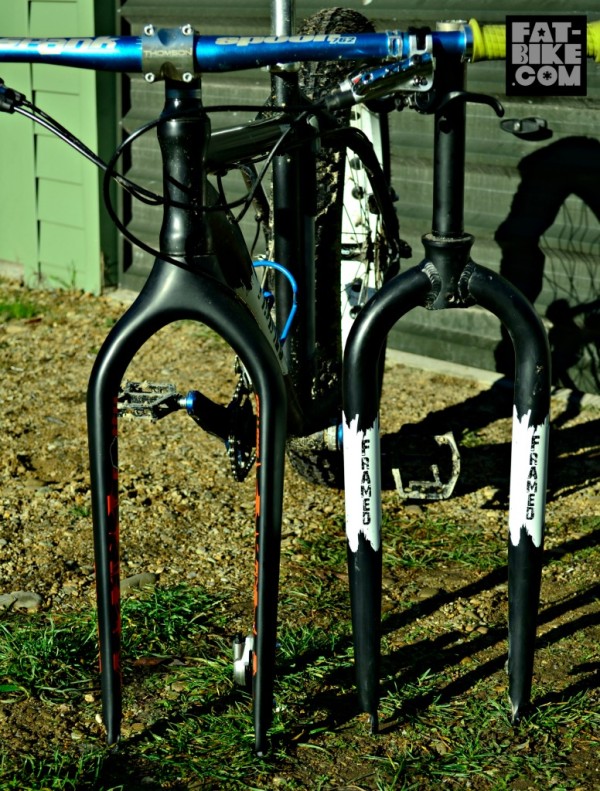We’re pleased to introduce Kevin Higgins. Kevin is a new correspondent from Alexandra, NZ which is an hour from Queenstown and Wanaka, and surrounded by epic riding! Kevin was born and raised in San Jose, California but now lives with his wife in New Zealand. Kevin runs a small bicycle business called Hellcat Cycles. He revitalizes prewar bikes for rental around Lake Wanaka and the Central Otago Rail Trail. Kevin wants us all to know that New Zealand is truly mountain biking’s best kept secret! ~gomez~
On One Carbon Fatty Fork
By – Kevin Higgins
I’d been shopping around for a carbon fork upgrade for a while but was at a bit of a loss as to which brand to go with. Carbon frame or fork companies don’t really advertise where they get their material from or even  disclose who the manufacture is or where they’re made. On One proudly advertise (there’s even a little sticker on the inside of the fork leg) that none other than Mitsubishi manufactures their carbon fork for them and with a legendary history of purpose built rally cars that have much of their body pieces made from carbon fiber, I was more than happy putting faith in a carbon fork made by the Japanese firm.
disclose who the manufacture is or where they’re made. On One proudly advertise (there’s even a little sticker on the inside of the fork leg) that none other than Mitsubishi manufactures their carbon fork for them and with a legendary history of purpose built rally cars that have much of their body pieces made from carbon fiber, I was more than happy putting faith in a carbon fork made by the Japanese firm.
An advertised weight of 650 grams meant a 250 gram savings off the front end and with an RRP of $200USD and free international shipping (an extra score for me living in New Zealand) good value as well. Happily, the value didn’t end there. When the fork showed up and I put it on the scale, it weighed in at a piddly 550 grams! The axle to crown is 10mm shorter than the stock fork (470mm) and the offset is 10mm more forward (55mm). I initially thought this might be a bit of an issue, but it’s turned out to be a blessing. The 10mm shorter axle to crown may steepen the head angle by a fraction but because the front wheel sits further forward you don’t notice. What you do notice is the slightly longer wheelbase and how much more composed the bike is at speed. An added headset spacer compensates for the lower front end and keeps the cockpit in the same position as stock.
As far as ride quality goes it’s been a massive improvement. I purchased the Framed Minnesota mostly out of curiosity (check out “The Fat and the Curious”) and after a few rides became convinced that fat bikes are the future. However, after a few rides it became clear that I probably should have spent a bit more…even if it was out of curiosity. While the welds are solid and consistent, the stock fork legs aren’t what you would call even and if the QR wasn’t tightened just right, the brake caliper would rub. It’s not uncommon to have this kind of inconsistency with inexpensive frames and forks. Also, under hard braking on steep terrain, I could watch the fork legs flexing under the force causing the front wheel to judder about which caused my bike’s handling to suffer. Both of these issues have vanished with the carbon On One Fatty. The alignment of the front wheel is spot on and there is zero noticeable flex under hard braking. This fork manages to feel remarkably stiff while maintaining a very compliant and forgiving ride through the little hits and judders.
It’s available in white or clear coated black carbon both with orange splat graphics on the inside legs. I would recommend this to anyone looking for an upgrade and I have nothing but praise for the UK based company able to provide such a great product at such a competitive price. I imagine those running steel forks would really notice a weight savings and so long as you’re not bothered by not having oodles of mounts (because there are none), do yourself and your fat friend a favour and get ‘On One’….see what I did there?
For more information about On One visit – www.on-one.co.uk




What brand frame and model was the fork mounted on?
Framed Minnesota 2.0
Same bike, same fork. How did you deal with the front disk spacing issue? Didn’t see it mentioned in the article. I modified my caliper adapter to align the brake and rotor.
I did have to machine the adapter down, I tend to try not to mod calipers if I can help it. The caliper adapter that came stock on the bike had been machined down to within an inch of it’s life. I left this out of the article because others experiences with these issues will vary depending on the front hub they run. Thanks for the read!
I noticed it on the stock as well. I went with a 180 rotor and adapter, as there was more area to work with on the larger piece. Didn’t hurt to get more stopping power for those big tires.
Good thing im a machinist, because its not easy to fit the caliper with the fork. It need some adjustement. Don’t buy it if you don’t have an access to a machine shop.
hrmpf..what kind of machining is necessary to make this work with the Framed Minnesota 2.0? Is there something else I can purchase instead? I’m a noob when it comes to working on my own stuff, but I’m handy by trade and would love a inexpensive carbon fork.
It doesn’t look like much of the original Minnesota build remains. Frame and wheels only from the looks of it?